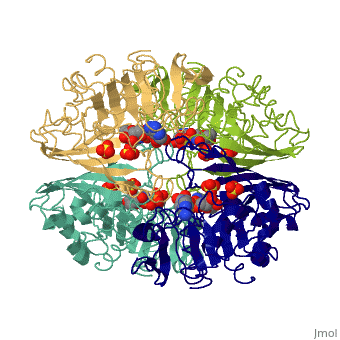Glyceraldehyde-3-Phosphate Dehydrogenase
From Proteopedia
(New page: ==Glyceraldehyde-3-Phosphate Dehydrogenase== This is a placeholder text to help you get started in placing a Jmol applet on your page. At any time, click "Show Preview" at the bottom of t...) |
|||
| Line 1: | Line 1: | ||
==Glyceraldehyde-3-Phosphate Dehydrogenase== | ==Glyceraldehyde-3-Phosphate Dehydrogenase== | ||
| - | + | Glyceraldehyde-3-phosphate dehydrogenase (GAPDH) is a very important enzyme in the production of energy. This enzyme catalyzes the sixth step in the process of breaking down glucose into energy, also known as glycolysis. Though this is its main function, GAPDH has been shown to perform other functions including transcription activation, initiation of apoptosis, and ER to Golgi apparatus vesicle transportation. However, this page will focus on GAPDH’s role in glysolysis. | |
| - | + | GAPDH most commonly exists as what looks to be a dimer. Interesting though, the two monomers of the enzyme are not exactly the same. While one side consists only of parallel beta-sheets, the other monomer is made up of both beta-sheets and alpha helixes. This is consistent with the following SCOP information: | |
| - | + | Class: Alpha and beta proteins (a/b) | |
| + | Fold: NAD(P)-binding Rossmann-fold domains | ||
| + | Superfamily: NAD(P)-binding Rossmann-fold domains | ||
| + | Family: Glyceraldehyde-3-phosphate dehydrogenase-like, N-terminus domain | ||
| + | Protein: Glyceraldehyde-3-phosphate dehydrogenase | ||
| + | Species: Human | ||
| + | The specific reaction that GAPDH catalyzes is shown below: | ||
| + | |||
| + | The mechanism of the glycolysis reaction is fairly straight forward. After the aldehyde enters the active site, the sulfhydryl groups attacks the nucleophilic carbon to form a thiohemiacetal. This intermediate undergoes oxidation due to a hydride transfer to a nearby NAD+ forming a thioester. From here, a phosphate group enters and attacks the same carbonyl while at the same time it is separated from the cystine by the protonated histidine group. This produces the desired 1,3-bisphosphoglycerate. | ||
| - | Replace the PDB id (use lowercase!) after the STRUCTURE_ and after PDB= to load | ||
| - | and display another structure. | ||
{{STRUCTURE_3gpd | PDB=3gpd | SCENE= }} | {{STRUCTURE_3gpd | PDB=3gpd | SCENE= }} | ||
Revision as of 00:37, 28 February 2010
Glyceraldehyde-3-Phosphate Dehydrogenase
Glyceraldehyde-3-phosphate dehydrogenase (GAPDH) is a very important enzyme in the production of energy. This enzyme catalyzes the sixth step in the process of breaking down glucose into energy, also known as glycolysis. Though this is its main function, GAPDH has been shown to perform other functions including transcription activation, initiation of apoptosis, and ER to Golgi apparatus vesicle transportation. However, this page will focus on GAPDH’s role in glysolysis. GAPDH most commonly exists as what looks to be a dimer. Interesting though, the two monomers of the enzyme are not exactly the same. While one side consists only of parallel beta-sheets, the other monomer is made up of both beta-sheets and alpha helixes. This is consistent with the following SCOP information: Class: Alpha and beta proteins (a/b) Fold: NAD(P)-binding Rossmann-fold domains Superfamily: NAD(P)-binding Rossmann-fold domains Family: Glyceraldehyde-3-phosphate dehydrogenase-like, N-terminus domain Protein: Glyceraldehyde-3-phosphate dehydrogenase Species: Human The specific reaction that GAPDH catalyzes is shown below:
The mechanism of the glycolysis reaction is fairly straight forward. After the aldehyde enters the active site, the sulfhydryl groups attacks the nucleophilic carbon to form a thiohemiacetal. This intermediate undergoes oxidation due to a hydride transfer to a nearby NAD+ forming a thioester. From here, a phosphate group enters and attacks the same carbonyl while at the same time it is separated from the cystine by the protonated histidine group. This produces the desired 1,3-bisphosphoglycerate.
| |||||||||
| 3gpd, resolution 3.50Å () | |||||||||
|---|---|---|---|---|---|---|---|---|---|
| Ligands: | , | ||||||||
| Activity: | Glyceraldehyde-3-phosphate dehydrogenase (phosphorylating), with EC number 1.2.1.12 | ||||||||
| |||||||||
| |||||||||
| Resources: | FirstGlance, OCA, PDBsum, RCSB | ||||||||
| Coordinates: | save as pdb, mmCIF, xml | ||||||||
Proteopedia Page Contributors and Editors (what is this?)
Michal Harel, Nathan Line, Andrew Swart, Alexander Berchansky, Alice Harmon, David Canner


